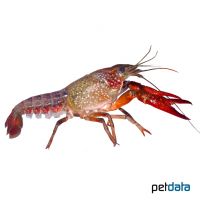Louisiana Crawfish (Procambarus clarkii)
| Louisiana Crawfish Procambarus clarkii | |
|---|---|
| Name | Louisiana Crawfish |
| Name Lat. | Procambarus clarkii |
| Synonym | Red Swamp Crayfish |
| Family | Cambarid Crayfishes |
| Family lat. | Cambaridae |
| Order | Decapods |
| Order lat. | Decapoda |
| Origin | USA |
| Habitat | Streams, ponds, swamps |
| Diet | Crayfish food, leaves, carrion |
| pH | 6.0-8.0 |
| Behavior | Aggressive |
| Keeping | Individual, pair, group |
| Care Level | Easy |
| Reproduction | Oviparous |
| Breeding | Simple |
| Life Span | 3-6 years |
| Protection | No |
| Metric Units | |
| Size | 6-12 cm |
| Temperature | 5-28 °C |
| Hardness | 5-15 °dH |
| Aquarium | ~ 100 l |
| US Units | |
| Size | 2.4"-4.7" |
| Temperature | 41-82 °F |
| Hardness | 89-267 ppm |
| Aquarium | ~ 25 gal |
Distribution and habitat
The wild form of the Louisiana crayfish originates from the southern United States and lives primarily in stagnant or gently flowing waters, but also in marshes and floodplains and, buried in moist soil, can survive periods of drought
Maintenance
They require a well-structured aquarium with roots, stones and robust plants, with hiding places (caves, crab tubes) and a moderate current. The burrowable substrate of sand or fine gravel should be partially covered with foliage (e.g. sea almond leaves, oak leaves), which also serves as food.
No ammonia, ammonium and nitrite should be detectable in the aquarium water, the nitrate value should not exceed 100 mg/l. To ensure water quality and oxygen content, a filter and heater adapted to the size of the aquarium is required, as well as lighting for the proper day-night rhythm of the animals.
Diet
They are omnivores that feed on animal organisms, carrion and dead plant material. For a balanced diet, feed once daily with a high-quality crayfish food (pellets, sticks) supplemented with insect larvae (live or frozen), fish, crayfish or shrimp meat, and foliage (e.g., sea almond, oak, beech). Occasionally, plant food in the form of spirulina, kelp or scalded leafy vegetables should be offered.
Unaccepted food must be removed after 2-3 hours. Regular and varied feeding promotes health and prevents deficiency symptoms.
Behaviour and compatibility
They behave aggressively within the species, but also towards other crayfish, therefore keeping several pairs or groups is only recommended in a much larger and richly structured tank. They can be socialized with shrimps, snails and smaller peaceful fish, but it is better to keep them in a species tank.
Basically, only compatible animals with similar demands on water quality and water temperature should be socialized.
Reproduction and breeding
Males can be identified by their larger claws and gonopods (mating styli) on the abdomen of the underside of the body. During mating, the male turns the female onto her back shortly after her molt and transfers a sperm package with his gonopods. The female carries the eggs (100-150 of them) on her pleopods (webbed feet) and supplies them with oxygen by movement (fanning). Dead or non-developing eggs are eaten by the female. The young hatch after about 4 weeks.
Important
Attention: EU-DVO 2016/1141 Invasive species
Louisiana crayfish come in several color morphs. They do not have special requirements for water quality and can stay on land for a long period of time (semiterrestrial)
The aquarium must be well covered, because the good climbers are escape specialists.
Each crayfish must have at least one cave (e.g. crayfish tube) of its own in which it can hide and also to be able to shed its skin undisturbed
It can happen that a crayfish is missing a claw. Usually it is females that have lost a claw during mating. The missing claw slowly grows back during the following molts. The strong claws are also used for digging.
The well-being of the animals should be checked regularly. Temperature should be checked daily, pH, hardness and nitrate levels at least every 14 days. Regular partial water changes are recommended, even if the contaminant level has not yet reached the upper limit. Sudden changes in water quality should be avoided. Newly introduced animals must be accustomed slowly to the water in the aquarium.
Further literature can be found in your pet store.
References
Text: Barbara Pachner; Image: petdata
Source: LUKHAUP & PEKNY (2008): Süßwasserkrebse aus aller Welt, Dähne Verlag; ENGELMANN & LANGE (2011): Zootierhaltung - Tiere in menschlicher Obhut: Wirbellose, Verlag Harri Deutsch
